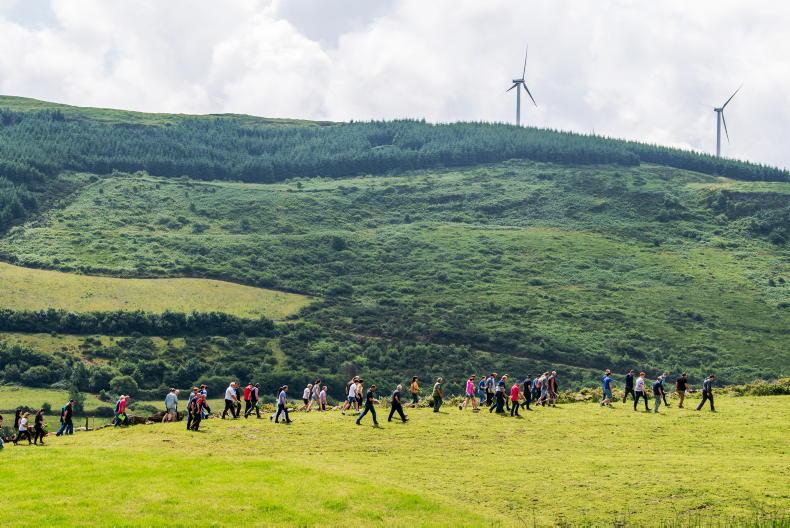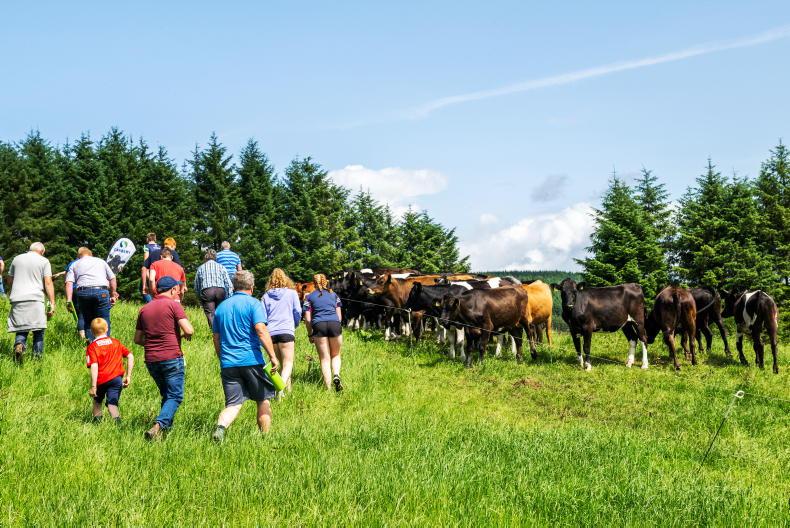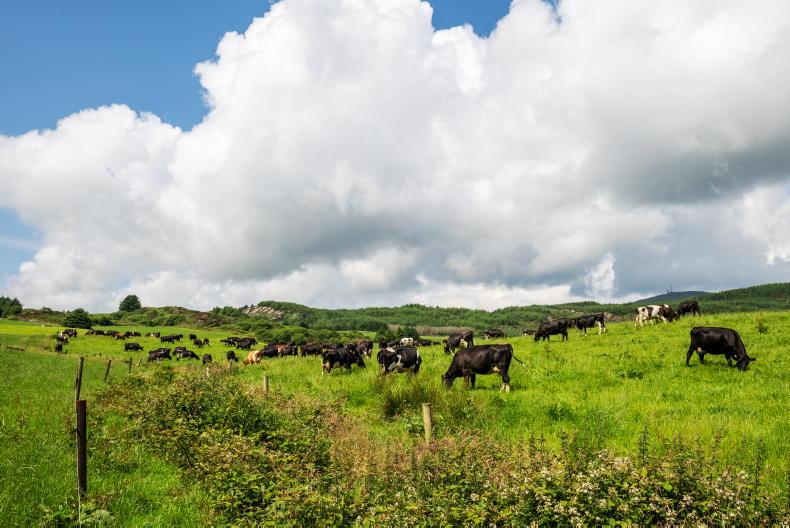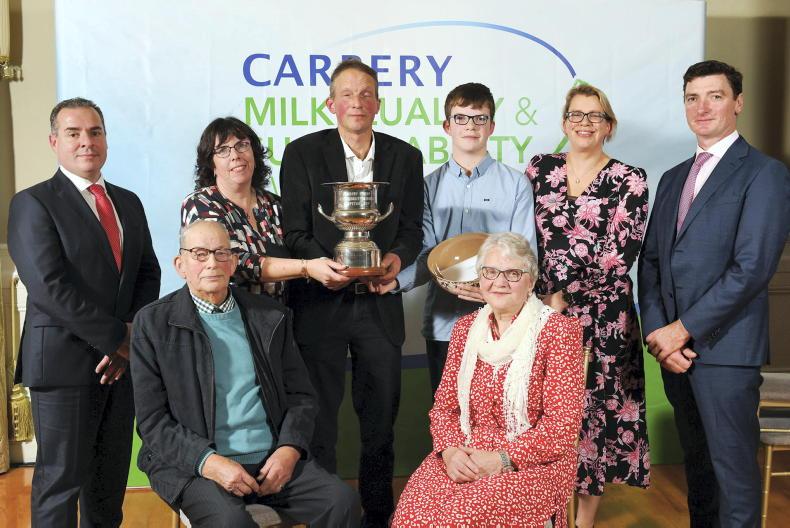Hundreds of farmers availed of the opportunity to view the farm of Ian and Marie Kingston, the 2022 Carbery Milk Quality Award winners, recently. Boasting all the standard infrastructure found on dairy farms, in terms of topography and terrain, you would be forgiven for thinking you were on a beef and sheep farm in the hill country of New Zealand instead of an Irish dairy farm.
Situated on high ground west of Dunmanway town, the exposed farm has a commanding view looking east and south over west Cork. Those arriving for the farm walk will have noticed that from the moment they entered the farm they were driving and walking up.
Rising from 500ft to 850ft above sea level, the upper reaches of the grazing platform are surrounded by mountain and forestry. That altitude contributes to higher rainfall with the average annual rainfall always over 2,000mm, with Ian recording a high of 2,500mm (98 inches) in 2020.
The Kingston philosophy is about having a farming system that is focused on keeping a simple system and doing it to a high standard.
The emphasis is on growing and utilising as much grass as possible. This, combined with breeding efficient, fertile and healthy cows, converts this grass into milk in a profitable system.
Purchased by Ian’s grandfather in 1911, the farm has been continually developed and added to since then and the family have, by Ian’s admission, learned to live with it and adapted to the farm.
That adaption begins with grassland management. The farm grew 11.7t/ha in 2022. Ian said: “We don’t grow big volumes. Grass growth doesn’t follow the growth curve like on most farms. It spikes from mid-May to mid-September when growth rates get into the 70s but the farm is slower to get going in spring and faster to tail off down to between 15kg DM/ha and 20kg DM/ha from mid-September.”
In order to attain the target of an average farm cover (AFC) of 600kg DM/ha by 1 December and an opening cover of around 700kg/ha to 750kg/ha, Ian starts closing paddocks around 25 September or even before that depending on the grass cover.
In 2022, they milked 171 cows and reared all youngstock on the 97.2ha farm with an overall farm stocking rate of 2.17 LU/ha.

Learning from others is a hallmark of the Kingston farming system.
The milking platform consists of 82.6ha with the balance of the land used for silage and after second cut is taken, the calves go to one block and the replacement heifers to the other.
Pressure
Extra grass demand from youngstock can put pressure on milking platforms on many dairy farms and contract rearing has become an option for many but due to the nature of the ground, Ian feels contract rearing is not something that would work for him.
“Youngstock are a bit like a tap, in that the ground is there for them. If conditions allow, the weanlings graze the silage ground before closing it for silage and then they come back for breeding. They might get out there again in the autumn.
“Calves don’t really have a big grass demand until May so that frees up the milking platform for the cows early in the year and gives us a lot more wriggle room in the shoulders. I can’t justify contract rearing due to that. I looked at it several times but it wouldn’t work.”
Calving begins in the last days of January and as soon as there are a bunch of cows ready to go to grass, they are let out for a few hours’ grazing and brought back in after.

A large crowd attended a farm walk on the dairy farm of Ian Kingston in June. \ Andy Gibson
To facilitate this, the farm is served by a good road network. It’s a long, narrow farm and all of it is accessible by farm roadways.
“You can access two acres anywhere on the farm without having to go over other ground. We also installed a pair of underpasses in 2021 and they have been a great help. We don’t have to hold cows after milking or don’t need extra help to move across the public road.”
Other labour savers that Ian has found beneficial are connected to the parlour.
He installed an 18-unit parlour in 2003. He added electric feeders to it since, along with automatic cluster removers (ACR) and cluster cleaners. “They streamline the labour and make it easier. The cluster cleanse, in particular, is a huge bonus in terms of reducing the risk of infection passing from one cow to another. The ACRs have helped too as we were probably over milking. They have both made a big difference.”
Ian has help from his family and has two other locals, one is a local farmer who works a few days a week. They have a flexible arrangement that suits both parties while another local comes into milk the cows three evenings a week.
Along with grassland management, having a cow adapted to the farm is important to the Kingstons.
Initially involved in the first Norwegian Red trials in Moorepark, the positive results gave Ian the confidence to crossbreed with Jersey bulls on their own Friesian herd.
“Crossbred cows have proved very suitable for our system here. We try to breed a cow that will last and does the business. We’ve been lucky. Apart from losing half the herd to TB 20 years ago, we have our own back breeding that is the backbone of the herd.
“When EBI arrived, we focused strongly on choosing bulls that were high for the fertility sub index and milk composition. Initially, these bulls came from the late Peter Daly and had New Zealand genetics. We found those genetics a bit hardier and suited to the farm.
“Now, we are fortunate that we have Irish-bred bulls from Munster Bovine that fit our criteria. It’s a long road. Nothing happens overnight when it comes to breeding.”
Having a tough animal fit for the farm, whose furthest point from the yard is 1.8km, is part of the reason behind the herd having a high EBI figure for maintenance of €29.
“I select bulls with a maintenance figure of €15 or greater as I don’t want a mature cow with a liveweight greater than 560kg.
“I don’t think a bigger cow will suit my land type and weather and she will use more of her feed intake maintaining herself rather than producing milk solids with it.”
When it comes to selecting bulls, fertility and health are held in high regard by Ian and he selected bulls this year with greater than €120 for fertility and at least as high as the existing herd for health (plus €6).
We made rapid progress increasing the milk solids and we weren’t the only farmers to do so
After that, it’s about trying to maximise the percentage fat and protein of the bulls provided. They are also positive for milk kilos. Improving milk solids is a continuous project. In 1992, the milk composition of the Kingston herd stood at 3.5% fat and 3.16% protein.
A decade later, this improved to 3.78% fat and 3.39% protein. By 2012, fat was up to 4.3% and protein 3.46% and, in 2022, the Kingstons delivered 455kg of milk solids/cow (4.6% fat and 3.75% protein) to Drinagh Co-op.
“We made rapid progress increasing the milk solids and we weren’t the only farmers to do so.
“We’re where we want to be here for a number of years but I am finding it harder to find bulls with dams that have percentages above the existing herd of 4.6% fat and 3.75% protein.
“I’ve taken the approach of picking a bull whose dam or granddam has produced over 4% protein as an experiment to see if it works. A Jersey could do it but there’s a risk of reducing yield and my aim is to hold or increase milk yield while improving solids.”
Ian used 78 sexed dairy AI straws in 2022 and had a 53% conception rate and a 93% heifer calf rate (38 heifer calves and three bulls). He was happy with those figures and 60% or 98 of the total straws used this year were sexed. He has a regular outlet for heifer calves and that’s a market he’s happy to continue supplying. Principally used in the first three weeks of breeding, Ian’s parameters for selecting a cow for sexed semen aren’t too complicated.

The Kingston philosophy is about having a farming system that is focused on keeping a simple system and doing it to a high standard. \ Andy Gibson
“She has to have calved before the middle of March and it is timing then as well. I’d like to inseminate them 14 to 20 hours after they show heat. Twelve cows got Angus within the first three weeks but the rest got dairy straws.”
Learning from others is another hallmark of the system. Joining the Greenacres Discussion Group in 1995, Ian became a Carbery monitor farmer in 1997 and subsequently joined the Greenfield Discussion Group.
By his own admission, Ian said clover is a work in progress. “The old clover is showing itself and doing fairly well, some of it is there over 10 years.”
White clover
“White clover was always in the reseeding mixes and since last year there’s 2kg of red going in every acre too.
“There’s about 20% of the farm with good clover. It didn’t get a lot of nitrogen last year and did well but this year it started to struggle more, so I’ve had to go in with some N to get it moving but the drought hit us in June.
“We had a lot of easterly wind and it dried out the place an awful lot so that probably contributed to the clover not doing as well this year so far.”
Hundreds of farmers availed of the opportunity to view the farm of Ian and Marie Kingston, the 2022 Carbery Milk Quality Award winners, recently. Boasting all the standard infrastructure found on dairy farms, in terms of topography and terrain, you would be forgiven for thinking you were on a beef and sheep farm in the hill country of New Zealand instead of an Irish dairy farm.
Situated on high ground west of Dunmanway town, the exposed farm has a commanding view looking east and south over west Cork. Those arriving for the farm walk will have noticed that from the moment they entered the farm they were driving and walking up.
Rising from 500ft to 850ft above sea level, the upper reaches of the grazing platform are surrounded by mountain and forestry. That altitude contributes to higher rainfall with the average annual rainfall always over 2,000mm, with Ian recording a high of 2,500mm (98 inches) in 2020.
The Kingston philosophy is about having a farming system that is focused on keeping a simple system and doing it to a high standard.
The emphasis is on growing and utilising as much grass as possible. This, combined with breeding efficient, fertile and healthy cows, converts this grass into milk in a profitable system.
Purchased by Ian’s grandfather in 1911, the farm has been continually developed and added to since then and the family have, by Ian’s admission, learned to live with it and adapted to the farm.
That adaption begins with grassland management. The farm grew 11.7t/ha in 2022. Ian said: “We don’t grow big volumes. Grass growth doesn’t follow the growth curve like on most farms. It spikes from mid-May to mid-September when growth rates get into the 70s but the farm is slower to get going in spring and faster to tail off down to between 15kg DM/ha and 20kg DM/ha from mid-September.”
In order to attain the target of an average farm cover (AFC) of 600kg DM/ha by 1 December and an opening cover of around 700kg/ha to 750kg/ha, Ian starts closing paddocks around 25 September or even before that depending on the grass cover.
In 2022, they milked 171 cows and reared all youngstock on the 97.2ha farm with an overall farm stocking rate of 2.17 LU/ha.

Learning from others is a hallmark of the Kingston farming system.
The milking platform consists of 82.6ha with the balance of the land used for silage and after second cut is taken, the calves go to one block and the replacement heifers to the other.
Pressure
Extra grass demand from youngstock can put pressure on milking platforms on many dairy farms and contract rearing has become an option for many but due to the nature of the ground, Ian feels contract rearing is not something that would work for him.
“Youngstock are a bit like a tap, in that the ground is there for them. If conditions allow, the weanlings graze the silage ground before closing it for silage and then they come back for breeding. They might get out there again in the autumn.
“Calves don’t really have a big grass demand until May so that frees up the milking platform for the cows early in the year and gives us a lot more wriggle room in the shoulders. I can’t justify contract rearing due to that. I looked at it several times but it wouldn’t work.”
Calving begins in the last days of January and as soon as there are a bunch of cows ready to go to grass, they are let out for a few hours’ grazing and brought back in after.

A large crowd attended a farm walk on the dairy farm of Ian Kingston in June. \ Andy Gibson
To facilitate this, the farm is served by a good road network. It’s a long, narrow farm and all of it is accessible by farm roadways.
“You can access two acres anywhere on the farm without having to go over other ground. We also installed a pair of underpasses in 2021 and they have been a great help. We don’t have to hold cows after milking or don’t need extra help to move across the public road.”
Other labour savers that Ian has found beneficial are connected to the parlour.
He installed an 18-unit parlour in 2003. He added electric feeders to it since, along with automatic cluster removers (ACR) and cluster cleaners. “They streamline the labour and make it easier. The cluster cleanse, in particular, is a huge bonus in terms of reducing the risk of infection passing from one cow to another. The ACRs have helped too as we were probably over milking. They have both made a big difference.”
Ian has help from his family and has two other locals, one is a local farmer who works a few days a week. They have a flexible arrangement that suits both parties while another local comes into milk the cows three evenings a week.
Along with grassland management, having a cow adapted to the farm is important to the Kingstons.
Initially involved in the first Norwegian Red trials in Moorepark, the positive results gave Ian the confidence to crossbreed with Jersey bulls on their own Friesian herd.
“Crossbred cows have proved very suitable for our system here. We try to breed a cow that will last and does the business. We’ve been lucky. Apart from losing half the herd to TB 20 years ago, we have our own back breeding that is the backbone of the herd.
“When EBI arrived, we focused strongly on choosing bulls that were high for the fertility sub index and milk composition. Initially, these bulls came from the late Peter Daly and had New Zealand genetics. We found those genetics a bit hardier and suited to the farm.
“Now, we are fortunate that we have Irish-bred bulls from Munster Bovine that fit our criteria. It’s a long road. Nothing happens overnight when it comes to breeding.”
Having a tough animal fit for the farm, whose furthest point from the yard is 1.8km, is part of the reason behind the herd having a high EBI figure for maintenance of €29.
“I select bulls with a maintenance figure of €15 or greater as I don’t want a mature cow with a liveweight greater than 560kg.
“I don’t think a bigger cow will suit my land type and weather and she will use more of her feed intake maintaining herself rather than producing milk solids with it.”
When it comes to selecting bulls, fertility and health are held in high regard by Ian and he selected bulls this year with greater than €120 for fertility and at least as high as the existing herd for health (plus €6).
We made rapid progress increasing the milk solids and we weren’t the only farmers to do so
After that, it’s about trying to maximise the percentage fat and protein of the bulls provided. They are also positive for milk kilos. Improving milk solids is a continuous project. In 1992, the milk composition of the Kingston herd stood at 3.5% fat and 3.16% protein.
A decade later, this improved to 3.78% fat and 3.39% protein. By 2012, fat was up to 4.3% and protein 3.46% and, in 2022, the Kingstons delivered 455kg of milk solids/cow (4.6% fat and 3.75% protein) to Drinagh Co-op.
“We made rapid progress increasing the milk solids and we weren’t the only farmers to do so.
“We’re where we want to be here for a number of years but I am finding it harder to find bulls with dams that have percentages above the existing herd of 4.6% fat and 3.75% protein.
“I’ve taken the approach of picking a bull whose dam or granddam has produced over 4% protein as an experiment to see if it works. A Jersey could do it but there’s a risk of reducing yield and my aim is to hold or increase milk yield while improving solids.”
Ian used 78 sexed dairy AI straws in 2022 and had a 53% conception rate and a 93% heifer calf rate (38 heifer calves and three bulls). He was happy with those figures and 60% or 98 of the total straws used this year were sexed. He has a regular outlet for heifer calves and that’s a market he’s happy to continue supplying. Principally used in the first three weeks of breeding, Ian’s parameters for selecting a cow for sexed semen aren’t too complicated.

The Kingston philosophy is about having a farming system that is focused on keeping a simple system and doing it to a high standard. \ Andy Gibson
“She has to have calved before the middle of March and it is timing then as well. I’d like to inseminate them 14 to 20 hours after they show heat. Twelve cows got Angus within the first three weeks but the rest got dairy straws.”
Learning from others is another hallmark of the system. Joining the Greenacres Discussion Group in 1995, Ian became a Carbery monitor farmer in 1997 and subsequently joined the Greenfield Discussion Group.
By his own admission, Ian said clover is a work in progress. “The old clover is showing itself and doing fairly well, some of it is there over 10 years.”
White clover
“White clover was always in the reseeding mixes and since last year there’s 2kg of red going in every acre too.
“There’s about 20% of the farm with good clover. It didn’t get a lot of nitrogen last year and did well but this year it started to struggle more, so I’ve had to go in with some N to get it moving but the drought hit us in June.
“We had a lot of easterly wind and it dried out the place an awful lot so that probably contributed to the clover not doing as well this year so far.”










 This is a subscriber-only article
This is a subscriber-only article










SHARING OPTIONS: